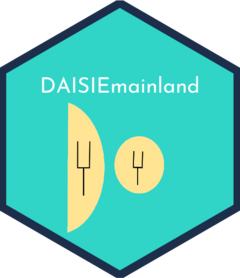DAISIEmainland guide

This guide is the long-form documentation of the DAISIEmainland R package.
It covers the basics from installation (Section 1), to the
algorithm used to simulate the data (Section 2), and
the visualisation of the mainland (Section 3.1) and of the
island (Section 3.2). Then there is a demonstration of
the application of the DAISIEmainland package to the inference models in the
DAISIE package (Section 4). Lastly, there is the
visualisation of the summary and error metrics that can be calculated from simulated data
(Section 5).
Overview
The DAISIEmainland package is used for simulating an island-mainland system.
It primary purpose is the simulation of phylogenetic data sets of island species
under a realistic model that incorporates evolutionary dynamics on the island and
the mainland, from which the island species immigrate. This is in contrast to the
inference and simulation models included in the DAISIE package (Etienne et al. 2022) which do not incorporate any changes in the mainland
species through time.
This novel model of mainland dynamics opens up the possibility of testing the
robustness of the DAISIE likelihood models under various scenarios of mainland
dynamics. We also include the incomplete sampling of mainland species, either by
not sampling a known species or an undiscovered species which is present on the
mainland but not known. These different sampling regimes are both possible in
empirical studies and thus the sensitivity of model performance to these are
important for future studies employing the DAISIE inference framework.
There is an appendix (Section A) which
contains details of the data structures used throughout the package, some of
which are novel to this package and others are inherited from other packages
(e.g. DAISIE). This appendix is meant for those looking to contribute and
extend the DAISIEmainland package by explaining when certain data structures
are used. If you are reading this guide to understand the general functionality
of the package this section can be ignored.

This work is licensed under a Creative Commons Attribution 4.0 International License.
